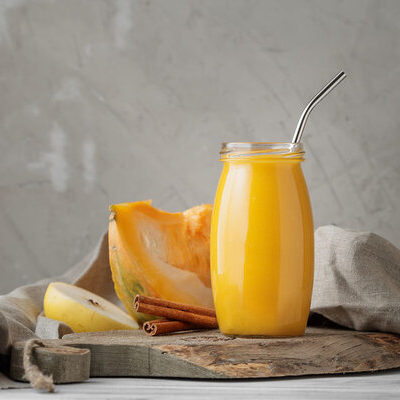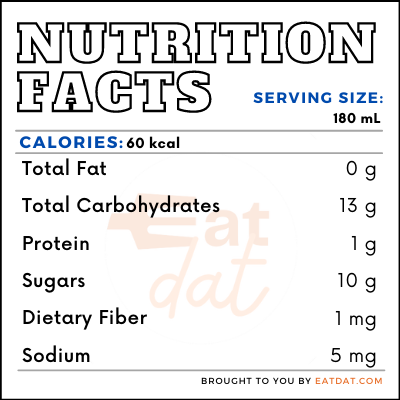
Pumpkin Juice
What is Pumpkin Juice?
Pumpkin juice is the juice extracted from raw pumpkins. Pumpkin juice may be consumed as a beverage, but it is also used to make soups, stews, desserts, and marinades. Pumpkin juice has a nutty and fruity flavor and can be sweet.
- There are five main types of pumpkins, which have different appearance and include Malabar gourd, winter squash, cushaw squash, Long Island cheese pumpkin, and Jack o’ lantern.
- The top pumpkin consuming and producing countries in the world are China, India, Ukraine, Russia, and the USA. Around 26,522,472 tons of pumpkin are produced every year.
Some common uses of pumpkin include:
- Pumpkin and Feta Muffins
- Pumpkin and Potatoes
- Pumpkin Oats Cake
- Roast Pumpkin Soup
- Baked Pumpkin
- Pumpkin and Spinach Pie
- Pumpkin Oambhal
- Pumpkin Halwa
- Erissery
- Asafoetida Roasted Pumpkin
Origin of pumpkin juice
Pumpkins most likely originated in Mexico. There have been archaeological discoveries of pumpkin seeds in the city of Oaxaca. These pumpkins date back 7,500 years and were small, hard, and bitter. Pumpkins were the first crops ever grown in North America. Pumpkin juice became hugely popular with the success of the Harry Potter books, in which it was a popular beverage among the students at Hogwarts.
Nutrition
The nutritional value for 180 mL of pumpkin juice:

Pumpkin is a good source of carotene, pectin, as well as other vitamins and minerals. Pumpkins are rich in vitamins A, C, and E, as well as lycopene and dietary fiber. The bioactive compounds, including carotenoids, tocopherols, and sterols, available in pumpkins can protect against hypertension, diabetes, cancer, and heart disease. Consuming pumpkin also helps with digestive problems and acts as an anti-inflammatory agent.
Commercial production
Pumpkin juice is made from raw, sweet pumpkins. Sometimes, it is mixed with other juices to improve its taste and attract customers. Usually, these include apple cider or apple juice.
To prepare this vegetable juice, first, the hard cover is peeled off and the seeds are removed. The pumpkin is then either blended into a puree or its juice is extracted. The former would give more pulp to the juice. After that, sugar and other seasonings are added. Finally, the mixture is pasteurized and bottled.
Pumpkin juice recipes
Though this juice is not everyone’s favorite, it has its culinary benefits and can be used to enhance different dishes. Here are a few recipes using pumpkin juice:
- Harry Potter Pumpkin Juice
- Pumpkin Coconut Milk Soup
- Pumpkin Shrimp Bisque
- Banana Pumpkin Smoothie
- Pumpkin Orange Cake
- Ginger Pumpkin and Rum Cocktail
FDA regulations
The FDA defines vegetable juice as juice prepared either by expressing the juice from mature varieties of fresh, edible vegetables, or by the water infusion of the dried vegetable. Pumpkins are also defined as an agricultural product which is rarely consumed raw. The USDA sets standards and grades for canned pumpkin puree and juice. Canned pumpkin is defined as the canned product prepared from clean, sound, properly matured, golden fleshed, firm shelled, sweet varieties of either pumpkins or squashes by washing, stemming, cutting, steaming, and reducing to a pulp. The product must also be heat-treated for preservation.
References
Amin, M Ziaul et al. “Comparative study on nutrient contents in the different parts of indigenous and hybrid varieties of pumpkin (Cucurbita maxima Linn.).” Heliyon vol. 5,9 e02462. 13 Sep. 2019, doi:10.1016/j.heliyon.2019.e02462, https://www.ncbi.nlm.nih.gov/pmc/articles/PMC6819838/
Yadav, Mukesh et al. “Medicinal and biological potential of pumpkin: an updated review.” Nutrition research reviews vol. 23,2 (2010): 184-90. doi:10.1017/S0954422410000107, https://pubmed.ncbi.nlm.nih.gov/21110905/
Tori Avey, History of Pumpkins and Recipe Round-Up, The History Kitchen, Public Broadcasting Service (PBS), https://www.pbs.org/food/the-history-kitchen/history-pumpkins-recipes
Countries by Pumpkin Production, Atlas Big, https://www.atlasbig.com/en-in/countries-by-pumpkin-production
Samantha Hunter, A Guide to All the Different Types of Pumpkins, Martha Stewart, https://www.marthastewart.com/2124321/pumpkin-varieties
